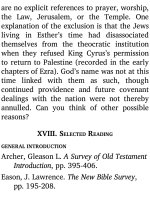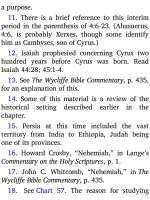Jensens survey of the old testament adam 182
Bạn đang xem bản rút gọn của tài liệu. Xem và tải ngay bản đầy đủ của tài liệu tại đây (118.22 KB, 4 trang )
As indicated earlier, the characters of the
dialogue of Canticles are Solomon, the
Shulamite woman, and the daughters of
Jerusalem. In the story, Solomon is the
bridegroom, and the Shulamite woman is
the bride.6 Two applications of typical
teaching may be intended.
1. Israel is the bride, and God the
Bridegroom. Read
these
other
Old
Testament passages where this bride and
groom relationship is clearly taught: Isaiah
54:5-6; Jeremiah 2:2; Ezekiel 16:8-147;
Hosea 2:16,8 18-20. Jewish believers of Old
Testament times clearly saw this typical
intent of Canticles, which helped to impress
them regarding the book’s canonicity.
2. The Church is the Bride, and Christ the
Bridegroom. Read Ephesians 5:23-25; 2
Corinthians 11:1-2; Revelation 19:7-9; 21:9.
A third application is derived from the
second, in the sense that an individual
believer (of the whole believing Church) is
the particular object of Christ’s love. From a
practical standpoint this is the most intimate
application which a Christian can make of
the book’s typical teaching for his own
Christian life.
Some Bible students see another character
involved in the story of Canticles: a
shepherd-lover (1:7), from whose a ection
Solomon tries to lure the Shulamite woman
away:
Solomon uses all the dazzle and
splendor of his court to woo the girl
away from her true love, seeking to get
her to become one of his wives instead.
In like manner the world is ever
seeking to attract away from Christ
those who are “espoused” to Him.
Solomon is unable to accomplish his
goal, however, for the Shulamite resists
all his overtures and remains true to
her beloved shepherd to whom, at last,
she is reunited.9
The reason why there are di erent views as
to the “plot” of Canticles is that the speakers
are not identi ed by name in the Bible text.
For example, the two-speaker view
(Solomon, Shulamite woman) says that
Solomon speaks all of 4:1-15; whereas the
three-speaker view says that Solomon is the
speaker of 4:1-6, while 4:7-15 are the words
of the shepherd-lover. But, as John Phillips
points out, “The abiding value of the Song of
Solomon is clear whichever view is taken. As
human life nds its highest ful llment in the
love of man and woman, so spiritual life
nds its highest ful llment in the love of
Christ and His Church.”10
An interesting comparison has been made
between Ecclesiastes and the Song of
Solomon involving their pointing to Christ:
In Ecclesiastes we learn that without
Christ we cannot be satis ed, even if
we possess the whole world—the heart
is too large for the object. In the Song
of Solomon we learn that if we turn
from the world and set our a ections
on Christ, we cannot fathom the
in nite preciousness of His love—the
Object is too large for the heart.11
I. PURPOSES
The purposes of the Song of Solomon are:
1. literal: to honor pure human love and
marriage
2. figurative: to show the Lord’s love for
Israel, and Christ’s love for His Church
and for each individual Christian; how
the Bride in each case should return that
love









